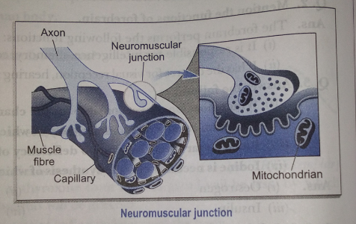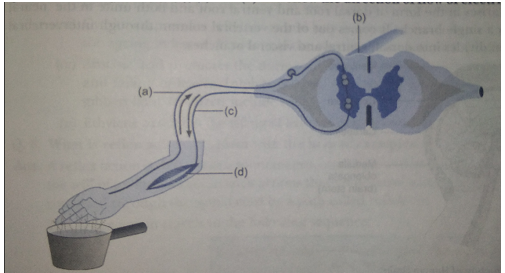Short Answer Questions - II - 3 Marks
Que 1. What are the advantages of the fact that most reflex actions are governed by spinal cord?
Ans. The advantages are:
(i) This enables the body to give quick responses to harmful stimuli thus protecting the body.
(ii) It minimises overloading of brain.
(iii) In many animals, reflex arcs have evolved as efficient ways of functioning in the absence of true thought processes.
Que 2. How do animal muscles move?

Ans. The nerve fibres at the end of a neuron are attached to muscles. This area is called neuro-muscular junction. When nerve impulses are conducted to this area, the special proteins present in the muscle cells change their shape and arrangement in the cell in response to nervous electrical impulses. New arrangement of these proteins give the muscle cells a shorter form thus bringing about movement of muscles.
Que 3. What is turgor movement?
Ans. Turgor movement is due to the difference of turgidity of the cells in the lower half and upper half of pulvinus (petiole of leaf). When leaf of touch-me-not plant (Mimosa pudica) is touched, the electrical signal send chemical signals from leaflets to pulvinus (petiole) of leaf. Cells in the lower half of pulvinus lose water and become flaccid, while cells in the upper half of pulvinus become turgid due to pulvinus lose water and become flaccid, while cells in the upper half of pulvinus become turgid due to accumulation of more water. Hence, leaf droops down for a short time.
Que 4. Why do tendrils coil around hard rough objects?
Ans. The growth movement of tendril in response to unilateral stimulus of touch is called thigmotropism. Tendrils of louki, tori, karela, and sweet pea plants coil around hard objects when they come in their contact. It occurs due to unequal growth of two sides of a tendril. The growth of the surface which comes in contact of the support is retarded, while it remains normal or increased on the other side, due to which tendril coils around the support.
Que 5. Why is pancreas called a 'dual function' gland? Write the names of its hormones.
Ans. Pancreas is an exocrine gland as well as an endocrine gland. Exocrine part of the gland secrets digestive enzymes and the endocrine part (Langerhan's cells) produce hormones. Hormones secreted by pancreas are insulin and glucagon.
Que 6. How is reflex arc formed?
Ans. A message or stimulus from receptor is receptor is relayed by sensory nerve to the spinal cord. It sends response through motor nerve to effectors for necessary action. This pathway is the reflex arc.

Que 7. How is the endocrine system able to maintain hormonal concentration in the body?
Ans. Hypothalamus is responsible for maintaining the balance of hormones in the body. When any hormone is secreted in large amounts, a signal is sent by the hypothalamus to the secreting gland to lower its secretion.
Whereas when the amount of any hormone is less, hypothalamus sends a signal to the respective gland to increase its functioning.
Que 8. Define 'nerve impulse'. Which structure in a neuron helps to conduct a nerve impulse
(i) towards the cell body? (ii) away from the cell body?
Ans. The information passing through neurons is in the form of chemical and electrical signals, called nerve impulse.
(i) Towards the cell body: Dendrites. (ii) Away from the cell body: Axon.
Que 9. Nervous and hormonal system together perform the function of control and coordination in human beings. Justify the statement.
Ans. Nervous and hormonal system together perform the function of control and coordination in human beings. Let us take an example, in the case of any emergency, stimulus is being perceived by CNS (nervous system). The stimulus is analysed and the response is sent to the effectors. Simultaneously, sympathetic nerves stimulate adrenal gland to release adrenaline which regulates blood pressure, increases heartbeat, constricts blood vessels and dilates pupil, etc. So, both nervous and endocrine systems interact and overcome the crisis together.
Que 10. How are the brain and spinal cord protected?
Ans. (i) Brain: It is protected by the bony box-cranium, also called as skull.
Also the membranes that surround the brain (meninges) are filled with cerebrospinal fluid that act as shock absorbers protecting the brain.
(ii) Spinal cord: The vertebral column, commonly called backbone, protects the spinal cord.
Que 11. Label the parts (a), (b), (c) and (d) and show the direction of flow of electrical signals in the figure.

Ans. (a) Sensory neuron (b) Spinal cord (CNS)
(c) Motor neuron (d) Effector-muscle in arm
Flow of electrical signals: Receptors in hand  Sensory neurons
Sensory neurons  spinal cord (CNS) Motor
spinal cord (CNS) Motor  neurons
neurons  Effector
Effector  muscles in arm.
muscles in arm.
Que 12. Name those parts of the flower which serve the same function as the following do in the animals:
(i) Testis (ii) Ovary (iii) Eggs Sperms
Ans.
|
In case of animal |
In case of flower |
|
Testis |
Anther/stamen/androecium Ovules |

